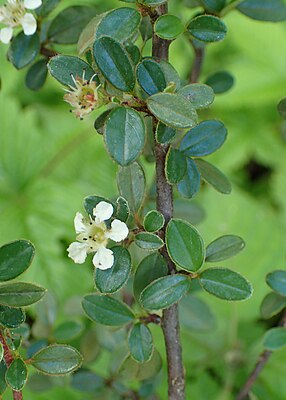Round-leaved cotoneaster
| Round-leaved cotoneaster | ||||||||||||
|---|---|---|---|---|---|---|---|---|---|---|---|---|

Round-leaved cotoneaster ( Cotoneaster rotundifolius ) |
||||||||||||
| Systematics | ||||||||||||
|
||||||||||||
| Scientific name | ||||||||||||
| Cotoneaster rotundifolius | ||||||||||||
| Wall. ex Lindl. |
The Rundblättrige cotoneaster ( Cotoneaster rotundifolius ) is an evergreen, up to 4 meters high shrub with dull red fruits from the group of maloideae (Pyrinae). The natural range of the species is in the Himalayan area. It is very rarely used as an ornamental plant.
description
The round-leaved cotoneaster is an evergreen, up to 4 meters high shrub with branches that bend in long arches. The twigs are gray to black-brown, initially yellowish, shaggy hairy and soon balding. The leaves are divided into a petiole and a leaf blade. The petiole is 1 to 3 millimeters long and finely hairy. The stipules are finely haired, persistent or falling off early. The leaf blade is simple, broadly ovate or rounded, 8 to 20 millimeters long and 6 to 10 millimeters wide, with blunt or marginalized, sometimes pointed and prickly-pointed tip and with a broadly wedge-shaped or rounded base. The upper side of the leaf is matt, glossy, dark green, glabrous or rarely finely haired; the underside is gray-green and finely hairy.
The inflorescences consist of 1 to 3 flowers . The bracts are linear-lanceolate and soon fall off. The flower stalks are hairy and 2 to 4 millimeters long. The flowers are about 10 millimeters in diameter. The flower cup is bell-shaped and finely hairy on the outside. The sepals are triangular and pointed. The petals are horizontal, they are white or reddish in color, broadly ovoid or obovate, 4 to 5 millimeters long and almost as wide, with a blunt or edged tip and a very short nailed base. The approximately 20 stamens are the same length or slightly shorter than the petals. The tip of the ovary is finely haired. The two to three free-standing styles are the same length or slightly shorter than the stamens. The red, obovate fruits are 7 to 9 millimeters in diameter. Two or three pips are formed per fruit. The round-leaved cotoneaster flowers from May to June, the fruits ripen from August to September.
The number of chromosomes is 2n = 68.
Occurrence and location requirements
The natural range is in the west of the Chinese province Sichuan , in the southeast of Xizang and in the northwest of Yunnan . Outside of China, they can be found in Bhutan, Nepal, and northern India. The round-leaved cotoneaster grows in cool, moist forests and on grassy slopes at 1200 to 4000 meters altitude on moderately dry to fresh, slightly acidic to alkaline, not too nutrient-rich soils in sunny to light-shady locations. The species is usually frost hardy .
Systematics
The Rundblättrige cotoneaster ( Cotoneaster rotundifolius ) is a kind of the genus of cotoneaster ( Cotoneaster ). It is in the family of the rose family (Rosaceae) of the subfamily spiraeoideae, tribes of the subtribe Pyreae maloideae assigned (Pyrinae). The species was in 1829 by John Lindley as Cotoneaster rotundifolia scientifically valid first described . The generic name Cotoneaster is derived from the Latin "cotoneum malum" for the quince ( Cydonia oblonga ). The ending "aster" is a coarse form for groups of plants that are considered inferior in comparison to similar groups. The specific epithet rotundifolius comes from Latin, rotundus means "round" and -folius means "-blättrig", together so "round-leaved".
use
The round-leaved cotoneaster is very rarely used as an ornamental shrub .
proof
literature
- Wu Zhengyi, Peter H. Raven, Deyuan Hong (Eds.): Flora of China . Volume 9: Pittosporaceae through Connaraceae . Science Press / Missouri Botanical Garden Press, Beijing / St. Louis 2003, ISBN 1-930723-14-8 , pp. 104 (English).
- Andreas Roloff , Andreas Bärtels: Flora of the woods. Purpose, properties and use. With a winter key from Bernd Schulz. 3rd, corrected edition. Eugen Ulmer, Stuttgart (Hohenheim) 2008, ISBN 978-3-8001-5614-6 , pp. 234-235.
- Jost Fitschen: Woody flora . 12th, revised and expanded edition. Quelle & Meyer, Wiebelsheim 2007, ISBN 3-494-01422-1 , p. 436 .
- Helmut Genaust: Etymological dictionary of botanical plant names. 3rd, completely revised and expanded edition. Nikol, Hamburg 2005, ISBN 3-937872-16-7 (reprint from 1996).
Individual evidence
- ↑ German name after Roloff et al .: Flora der Gehölze , p. 234 and after Fitschen: Gehölzflora , p. 436
- ↑ a b c d Zhi-Yun Zhang, Hongda Zhang, Peter K. Endress: Cotoneaster rotundifolius , in: Wu Zhengyi, Peter H. Raven, Deyuan Hong (eds.): Flora of China . Volume 9: Pittosporaceae through Connaraceae . Science Press / Missouri Botanical Garden Press, Beijing / St. Louis 2003, ISBN 1-930723-14-8 , pp. 104 (English).
- ↑ a b c d Roloff et al .: Flora of the Woods , pp. 234–235
- ↑ a b Cotoneaster rotundifolius. In: Germplasm Resources Information Network (GRIN). United States Department of Agriculture, accessed May 1, 2012 .
- ↑ D. Potter, T. Eriksson, RC Evans, S. Oh, JEE Smedmark, DR Morgan, M. Kerr, KR Robertson, M. Arsenault, TA Dickinson, CS Campbell: Phylogeny and classification of Rosaceae . Plant Systematics and Evolution, Volume 266, 2007, pp. 5-43. doi : 10.1007 / s00606-007-0539-9
- ↑ Exactly: Etymological Dictionary of Botanical Plant Names , p. 181
- ↑ Exactly: Etymological Dictionary of Botanical Plant Names , pp. 253 and 544
Web links
- Cotoneaster rotundifolius. In: The Plant List. Retrieved May 1, 2012 .